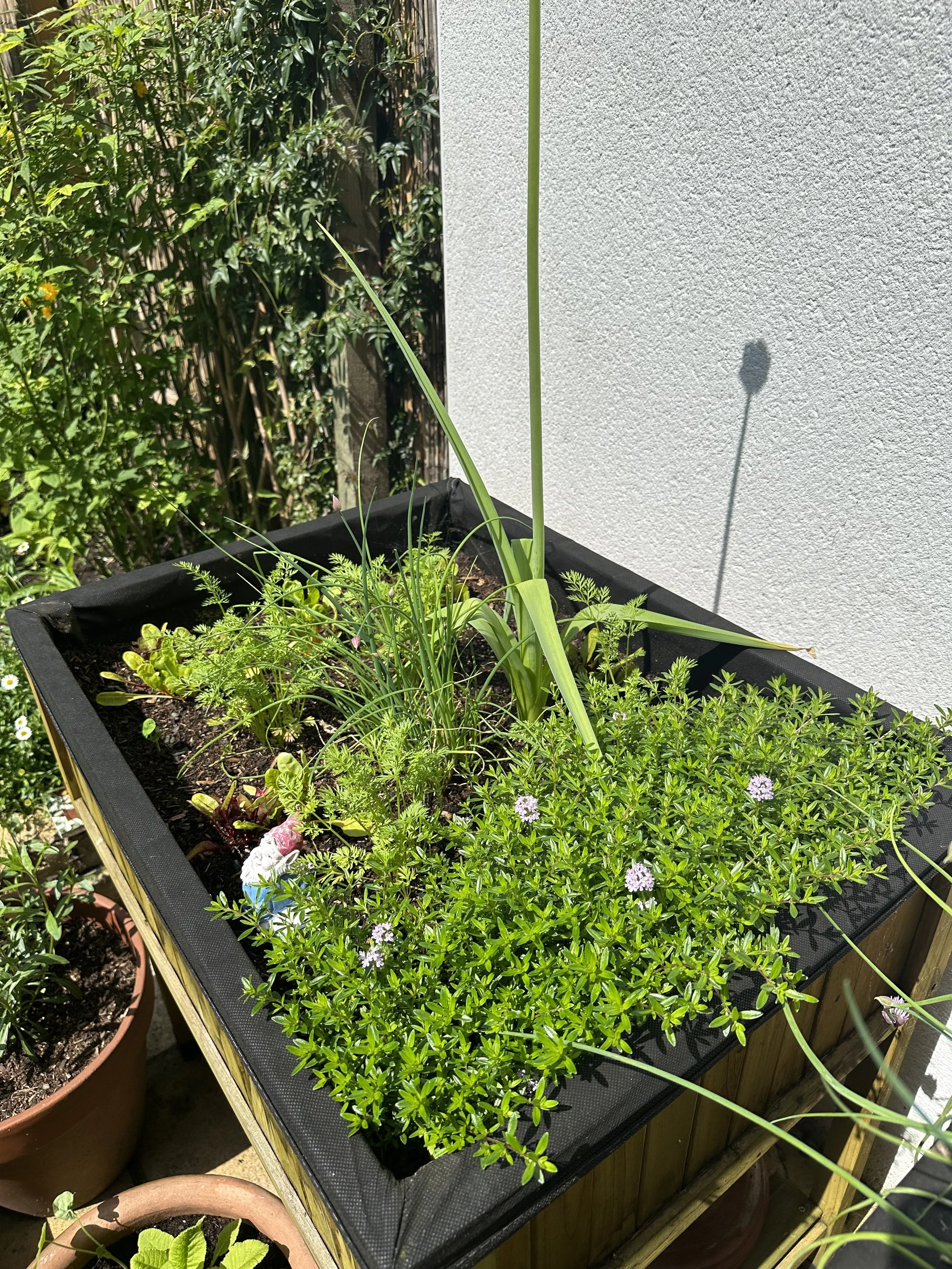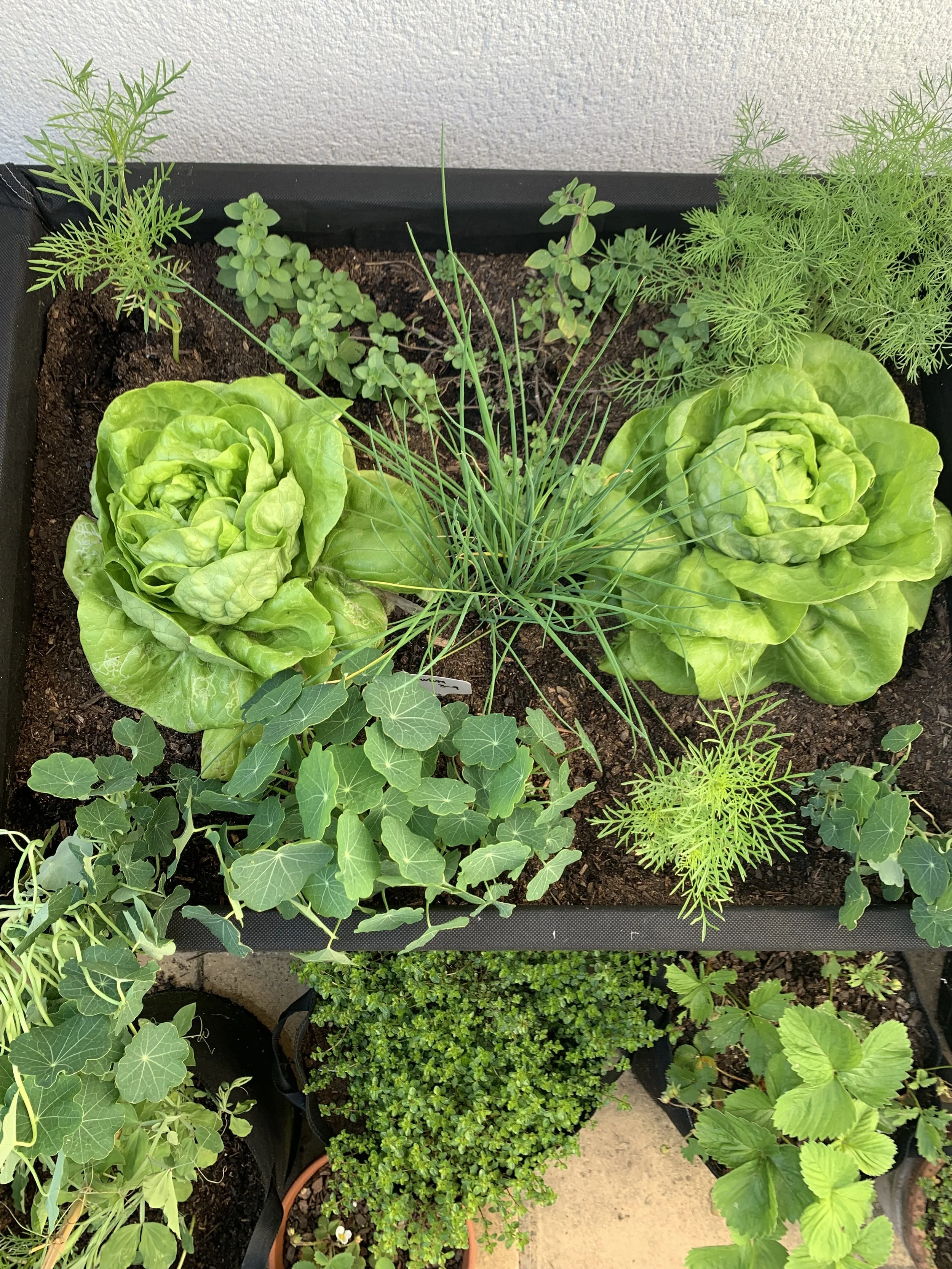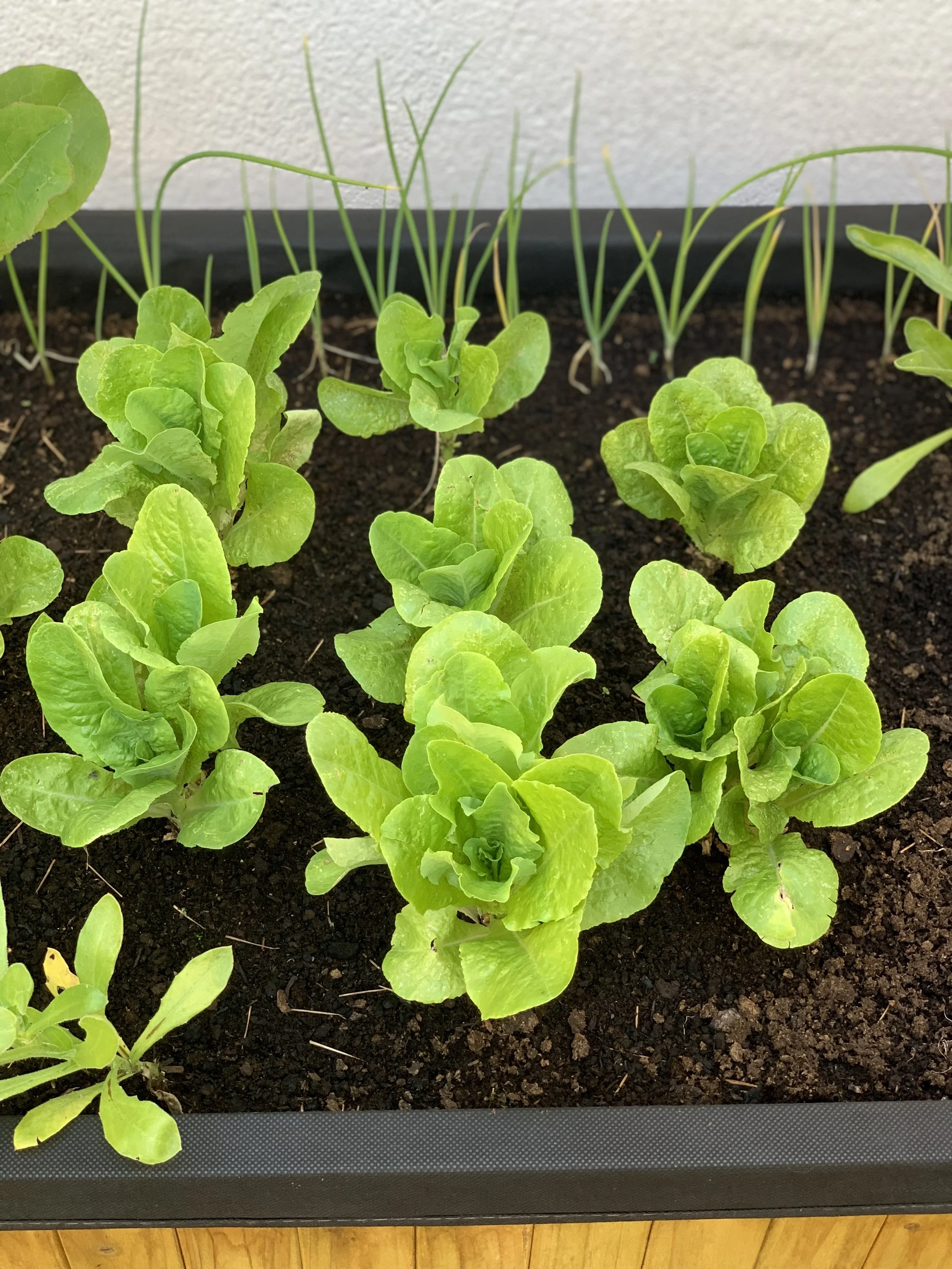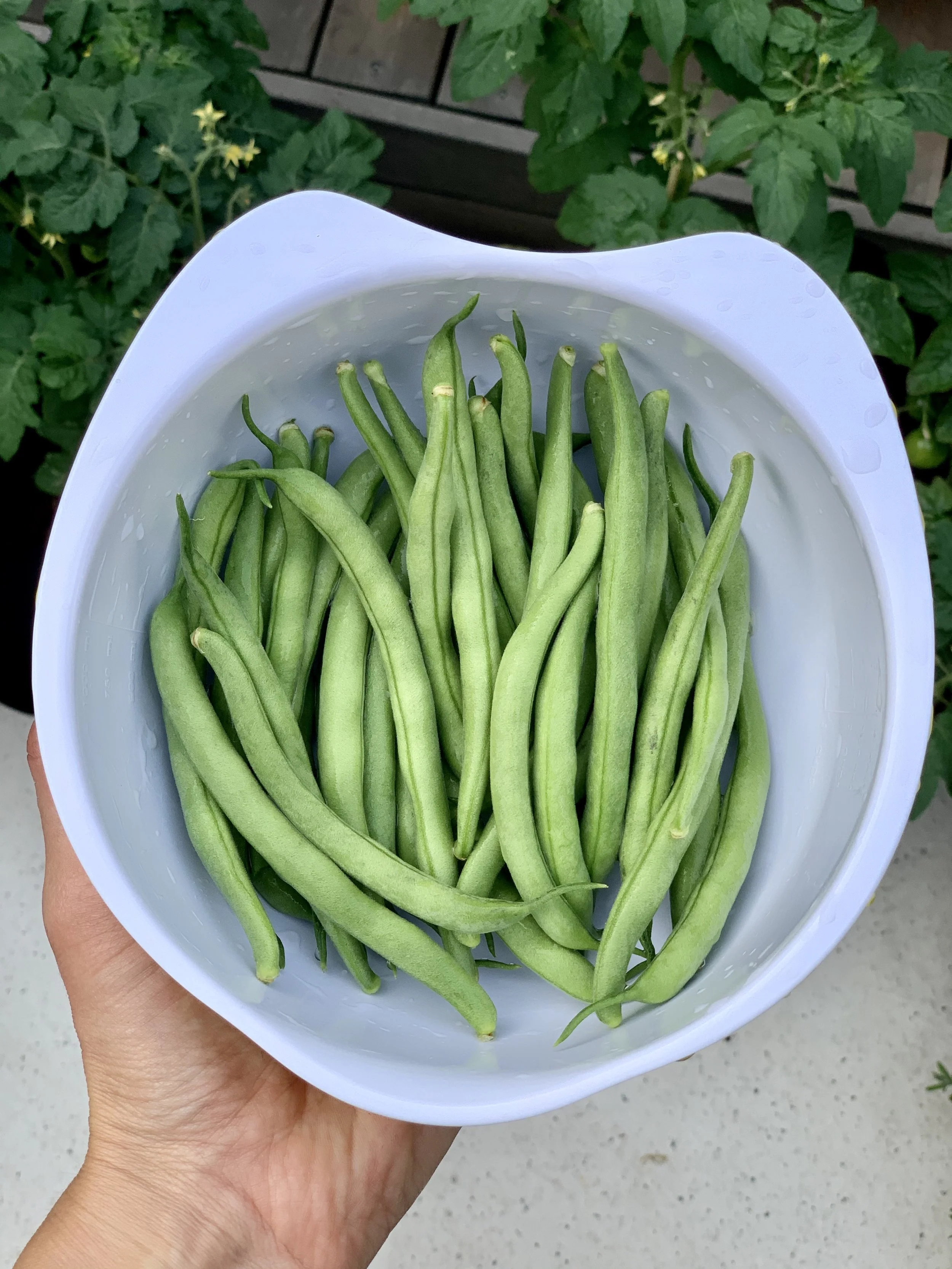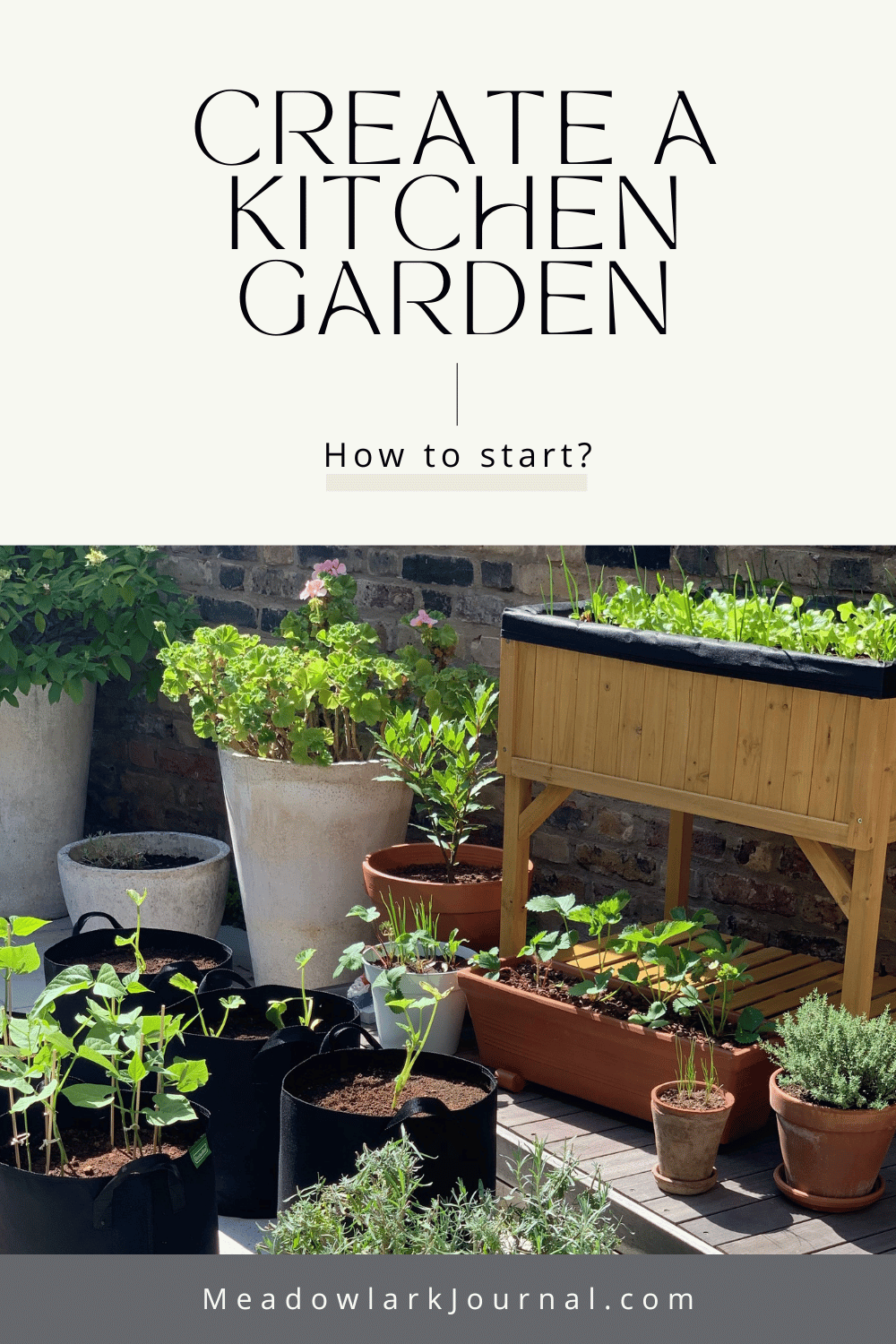What is a Kitchen Garden?
This website is reader-supported - thank you! This post may contain affiliate links. As an Amazon Associate, I earn from qualifying purchases at no extra cost to you.
Have you ever imagined stepping outside your kitchen to pick fresh herbs or harvest vegetables for your meal?
That’s the beauty of having your own kitchen garden—a dedicated spot close to your kitchen where you can grow edible plants ranging from herbs to delicious vegetables and even fruit-bearing trees depending on the space available.
A kitchen garden, or a potager as it's known in French, is more than just a plot of land; it's a way of integrating a space to grow your own food into your home.
Unlike larger vegetable gardens, which might be tucked away in a corner of your backyard, kitchen gardens are typically positioned for easy access and manageable upkeep, making them perfect for busy people or those with limited space.
For more tips, check out my guide:
The concept of kitchen gardening is not new.
Historically, they were essential at a time when people needed to rely on their own skills and land for food.
Today, they serve not just a functional purpose, but also a therapeutic one, offering a lovely escape into the world of gardening where every little effort brings tangible rewards.
In today's world, where organic and fresh is a priority for many, having a kitchen garden allows you to control what goes into your food and how it's grown.
It reconnects you with the cycles of nature in your very own backyard or balcony.
From leafy greens in the spring to root vegetables in the cooler months, kitchen gardens can yield a diverse array of produce across seasons.
Starting your own kitchen garden doesn’t require extensive gardening experience or a large footprint.
With a few raised beds or containers, some quality soil, and a selection of plants that do well in your region, you can create a beautiful and productive green space that enhances your home and diet.
As we explore further into the basics of kitchen gardening, planning your garden, and tips for maintenance, you'll see just how feasible and fulfilling growing your own food can be.
Learn more with my guides:
The Basics of Kitchen Gardening
A kitchen garden is primarily focused on producing fruit and vegetables for your kitchen, distinguishing it from ornamental gardens or larger-scale vegetable plots primarily aimed at preservation or storage.
Here’s what you need to know to lay the groundwork for a thriving kitchen garden:
kitchen garden Definition
A kitchen garden, often situated near the household for easy access, integrates both beauty and utility.
These gardens are not just functional but are designed to be beautiful to look at, blending in seamlessly with your home’s landscape.
They typically include a variety of plants such as vegetables, herbs, and sometimes small fruit trees, all cultivated organically to provide fresh produce right at your doorstep.
Choosing the Right Location
Sunlight is crucial.
Most vegetables and herbs require at least six hours of direct sunlight per day.
A south-facing, south-east facing, south-west facing, or west-facing garden aspect work best.
Select a spot that meets this requirement while also being conveniently accessible for quick trips out from the kitchen.
If space is limited, consider options like balcony containers or vertical gardening to maximize exposure to sunlight.
Soil Preparation
Good soil is the foundation of a productive garden.
For kitchen gardens, using raised beds can help control soil quality and drainage, making maintenance easier.
Here is the raised bed kit I recommend using:
Fill your beds with a mix of high-quality garden soil, compost, and other organic matter to ensure nutrient-rich, well-draining soil.
Here is the garden soil I recommend using:
Regular testing and amendments can keep your soil in top condition season after season.
Here is the soil pH tester I recommend:
Plant Selection
Choose plants based on your cooking needs and climate zone.
Common staples include:
Herbs:
Vegetables:
Leafy Greens:
Spinach, kale, and Swiss chard.
Fruit Trees:
Dwarf varieties of apples, pears, and plums, if space permits.
Group plants with similar water and sunlight needs together to streamline your gardening efforts.
For more planting tips, check out my guide:
Planning Your Kitchen Garden
Creating a kitchen garden that is both productive and beautiful requires thoughtful planning.
Whether you have sprawling backyard space or just a small balcony, the right approach can help you make the most of your gardening efforts.
Here's a step-by-step guide to planning your ideal kitchen garden:
Step 1: Assess Your Space
Start by evaluating the space available to you.
Consider factors like sunlight exposure, ease of access, and proximity to water sources.
For small spaces, think vertically—trellises, hanging baskets, and wall planters are great for maximizing productive space.
For larger spaces, consider the aesthetics of incorporating paths, larger plant beds, and maybe even seating areas for enjoyment.
Step 2: Decide What to Grow
Think about what vegetables, herbs, and fruits you and your family enjoy and use frequently in cooking.
It's best to start small with a few easy-to-grow plants that are known for their yield and hardiness in your climate zone.
Some quick wins include herbs (like basil and mint), leafy greens (such as lettuce and spinach), and root vegetables (like carrots and radishes).
For a quick win, here are my favorite radish seeds to grow:
Step 3: Design Your Layout
Sketch out a design on paper.
Arrange your plant beds north to south to maximize sun exposure, and consider raised beds or containers to improve drainage and ward off pests.
Plan your walking paths to be at least two feet wide for easy access.
Integrate companion planting to promote natural growth boosts and pest reductions—for instance, marigolds and nasturtiums can deter pests from your vegetables.
To learn more, check out my guide: How to Pair Marigold Companion Plants.
These are my favorite marigold seeds to grow in order to control pests:
Step 4: Soil Preparation
Prepare your soil by incorporating organic matter such as compost or well-rotted manure, which will provide nutrients and enhance soil structure.
Test your soil's pH and adjust it if necessary to meet the requirements of the plants you wish to grow.
Good soil prep is crucial for preventing diseases and ensuring your plants have the best environment for growth.
Here is the soil pH tester I recommend:
Step 5: Purchase Quality Seeds and Plants
Opt for high-quality seeds and seedlings.
Quality plants are less likely to carry diseases and have a better chance of thriving.
Consider starting seeds indoors if your growing season is short, and transplant them outside when the weather stabilizes.
To learn more about this, check out my guide When to Start Tomato Seeds Indoors.
Here are my favorite tomato seeds from a reputable seed source:
Step 6: Think About Watering Solutions
Plan a watering system that suits your garden's needs.
Drip irrigation is efficient and conserves water by directing it to the plant roots where it's needed most.
Here is the drip irrigation system I recommend:
If you're gardening in containers, make sure they have adequate drainage and consider self-watering pots that can help reduce maintenance chores.
Here are the self-watering containers I recommend:
Step 7: Tools and Equipment
Gather all the necessary tools before you begin planting.
Basic tools might include a spade, fork, hoe, trowel, watering can, and pruning shears.
To learn more, check out my guide: The Best Gardening Tool Sets for Every Gardener.
Step 8: Maintenance Plan
Develop a regular maintenance schedule that includes weeding, pruning, harvesting, and monitoring for pests.
Regular attention not only keeps your garden looking great but also helps plants produce more and prevents disease problems from becoming unmanageable.
Essential Tools and Techniques for a Thriving Kitchen Garden
To ensure your kitchen garden not only survives but thrives, it's crucial to equip yourself with the right tools.
Here’s a comprehensive guide to what you’ll need:
Essential Tools for Every Kitchen Gardener
Having the right tools can make the difference between a flourishing garden and a faltering one.
Here are the must-haves for any kitchen gardener:
Spade and Fork:
Essential for turning the soil, these tools help prepare your beds for planting.
Here is the spade I recommend:
Hoe:
Useful for weeding and breaking up soil, a hoe is a must for maintaining soil condition.
Here is the hoe I recommend:
Trowel:
For more precise work such as planting seedlings or digging small holes, a trowel is indispensable.
Here is the trowel I recommend:
Pruning Shears:
Necessary for trimming plants, cutting back overgrowth, and harvesting some types of vegetables.
Here are the pruning shears I recommend:
Watering Can or Hose with a Spray Attachment:
Ensures gentle watering that doesn’t disturb the soil or seedlings.
Drip irrigation systems are an efficient alternative, especially for larger gardens.
Here is the watering can I recommend:
Garden Rake:
Helps in leveling soil and clearing debris from the beds.
Here is the garden rake I recommend:
Gloves:
Protect your hands from thorns, chemicals, and dirt.
Here are the gloves I recommend:
Wheelbarrow:
Ideal for moving soil, compost, and other heavy materials around your garden.
Here is the wheelbarrow I recommend:
Effective Gardening Techniques
Once you have the right tools, applying the best gardening techniques will help you maximize the productivity of your kitchen garden:
Soil Management:
Start with a soil test to determine pH and nutrient levels, then amend accordingly with compost, manure, or other organic material to improve fertility.
Regularly aerate your soil to provide the necessary oxygen for root growth.
Water Management:
Water deeply but infrequently to encourage roots to grow deeper, making plants more resilient and drought-tolerant.
Early morning is the best time to water, reducing evaporation and helping to prevent fungal diseases.
For more watering tips, check out my guide: Water Butts: Sustainable Water Storage for Your Garden.
Crop Rotation and Companion Planting:
Rotate crops annually to prevent soil depletion and reduce pest and disease buildup.
Companion planting can enhance plant growth, deter pests, and maximize space.
To learn more about companion planting, check out my guide: The Best Companion Plants for Tomatoes.
Mulching:
Apply organic mulch around your plants to retain moisture, regulate soil temperature, and reduce weed growth.
Materials such as straw, bark, or leaf mold are effective choices.
To learn more about mulching, check out my guide: The Best Alternatives to Traditional Mulch for Your Garden.
Pest and Disease Control:
Monitor plants regularly for signs of pests and diseases.
Use organic methods to control problems, such as introducing beneficial insects, using neem oil, or applying sulfur-based fungicides.
Here is the neem oil I recommend:
Pruning and Deadheading:
Regularly prune overgrown plants and remove dead or diseased foliage to keep your garden healthy.
Deadheading flowers can also promote more blooms.
To learn more about deadheading, check out my guide: How to Deadhead Dahlias for Stunning Blooms.
Harvesting Techniques:
Harvest vegetables at their peak for the best flavor.
Regular harvesting often encourages plants to produce more yield.
To learn more about harvesting, check out my guide: When to Harvest Kale.
Seasonal Adjustments
Adjust your gardening practices based on the season:
Spring:
Prepare beds, start seedlings indoors, and begin to harden off plants for transplanting.
To learn more about water to plant in spring, check out my guide: What to Plant in April.
Summer:
Focus on watering and pest control during hot months. Plant heat-loving vegetables.
For more watering tips, check out my guide: How to Use Watering Globes.
Fall:
Plant cool-weather crops and begin to winterize your garden. Add mulch to protect overwintering plants.
Check out my guide: The 10 Best Autumn Bedding Plants.
Winter:
Plan next year's garden, order seeds, and maintain gardening tools.
To learn more about what to plant, check out my guide: What to Plant in February.
Benefits of Having a Kitchen Garden
Cultivating a kitchen garden is not just about fresh produce—it's about enriching your lifestyle, enhancing your environment, and even improving your health.
Here are some of the key benefits that come with maintaining a kitchen garden:
Fresh and Healthy Produce at Your Fingertips
Nutritional Richness:
Home-grown vegetables and fruits are typically more nutrient-dense than those bought from the store, mainly because they are consumed shortly after harvesting when they are at their nutritional peak.
Reduced Chemical Use:
When you control your own garden, you can limit the use of harmful pesticides and fertilizers, opting for organic solutions that are better for your health and the environment.
Enhances Mental and Physical Health
Exercise:
Gardening is a physical activity that contributes to maintaining healthy body weight, improving muscle strength, and reducing the risk of chronic diseases such as heart disease and obesity.
Stress Relief:
Spending time in a garden has been shown to significantly reduce stress levels, thanks to the calming nature of the activity and the satisfaction involved in nurturing plants.
Cost-Effective
Reduce Grocery Bills:
Growing your own food can help cut the cost of purchasing fresh produce from supermarkets, especially if you're growing high-yield plants like tomatoes and zucchini.
Less Food Waste:
When you appreciate how much effort goes into growing your food, you're less likely to waste it. Plus, you can harvest only what you need, minimizing spoilage.
Increases Biodiversity
Attracts Beneficial Wildlife:
A diverse garden can attract pollinators such as bees, butterflies, and birds, which are not only beautiful to watch but are crucial for plant reproduction.
Environmental Impact:
By planting a variety of crops, you contribute to the ecological health of your area, supporting your local environment.
Aesthetic Appeal
Beautifies Your Home:
A well-maintained garden enhances the overall appearance of your property, which can increase its curb appeal and potentially its market value.
Creates a Relaxing Retreat:
The beauty and tranquility of a garden provide a peaceful retreat from the bustle of daily life, offering a perfect spot to relax, read, or meditate.
Sustainability
Reduces Carbon Footprint:
By growing your own food, you decrease the dependence on supermarket foods that often involve long-distance transportation and heavy packaging, which contribute to carbon emissions and waste.
Water Conservation:
Gardening techniques like drip irrigation and proper mulching can help conserve water.
Quick FAQs
What exactly is a kitchen garden?
A kitchen garden, also known as a potager in French, is a small garden where vegetables, herbs, and fruits are grown primarily for household consumption.
Unlike ornamental gardens or larger agricultural plots, kitchen gardens are designed for easy access—often located just steps away from the kitchen door.
This type of garden not only focuses on practicality and convenience but also on beauty, incorporating elements of garden design to enhance the beauty of your home.
How does a kitchen garden differ from a vegetable garden?
While both kitchen gardens and vegetable gardens are cultivated for their edible crops, the key distinction lies in their design and purpose.
A kitchen garden is usually smaller than a traditional vegetable garden and is strategically placed closer to the kitchen for ease of access to fresh produce.
It often includes a mix of vegetables, herbs, and sometimes small fruit trees, and is designed to be beautiful.
In contrast, vegetable gardens might be located further from the living area, are typically larger, and focus more on long-term crop production.
Can I maintain a kitchen garden on a balcony or small space?
Yes, you can maintain a kitchen garden in small spaces such as balconies by utilizing containers, hanging baskets, or vertical gardening techniques.
Choose compact or dwarf plant varieties and consider hydroponics or a tabletop soil bed for efficiency and convenience.
Proper sunlight and regular watering are crucial, just as they would be in a larger garden.
What was the purpose for the kitchen garden?
Historically, the primary purpose of a kitchen garden was to supply fresh produce to households for daily meals.
These gardens were essential in times when refrigeration was not available, and store-bought produce was not an option.
They provided families with access to fresh vegetables, herbs, and fruits, ensuring a varied and vitamin-rich diet throughout the year.
Today, while modern conveniences have changed how we source our food, the purpose of a kitchen garden remains focused on freshness, flavor, and the joy of growing one’s own food.
What is the old term for kitchen garden?
The old term for a kitchen garden is "potager", a French term that is still widely used today, especially in English-speaking countries that embrace classic gardening traditions.
The potager is designed not only for its functionality but also for its beauty, often incorporating flowers and herbs that are both useful and attractive to enhance the garden's overall appeal.
Creating your own kitchen garden brings a blend of beauty and practical benefits.
By mastering the kitchen garden basics, you set the stage for a beautiful kitchen garden that not only enhances your home’s outdoor space but also contributes to a healthier, more sustainable lifestyle.
Whether you cultivate a rooted garden with deep beds of nutrient-rich vegetables, a fragrant herb garden, or meticulously designed garden beds, there are many rewards of kitchen gardening.
As you plan and plant your garden, remember that the key to success lies in understanding the needs of your plants and the unique conditions of your local environment.
From fresh herbs to crisp vegetables, your kitchen garden is a testament to what nature can offer right in your own backyard.
Pin this post to save it for later!

